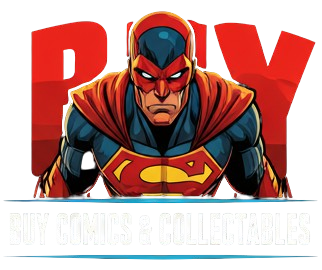
Grading Standards for Comics
At Buy Comics and Collectables, we assess comic book quality using the following grading standards. Keep in mind that while one small flaw may not significantly lower a comic's grade, a combination of multiple defects can reduce it by one or more grades.
We follow the grading guidelines set by the Overstreet Grading Guide, enhanced by over 40 years of experience in the comic book industry. Our team is regularly trained and calibrated to ensure consistency with these established standards. However, grading is a subjective process, and opinions may vary slightly. Even renowned grading services like CGC and CBCS recognize that a comic may not always receive the same grade if submitted multiple times.
Grading Scale Overview
- NM (Near Mint): Covers grades from 9.2 to 9.8 on the ten-point scale, with occasional exceptions as low as 9.0.
- VF (Very Fine): Includes grades ranging from 7.5 to 9.0, with some exceptions down to 7.0.
- FN (Fine): Spans grades from 5.5 to 7.0, occasionally including 5.0.
- VG (Very Good): Ranges from 3.5 to 5.0, with rare inclusions of 3.0.
- GD (Good): Covers grades from 1.8 to 3.0.
- FR (Fair): Includes 1.0 and 1.5 on the scale.
- PR (Poor): Assigned a grade of 0.5.
Near Mint (NM) Condition
- Grades: NM/M (9.8), NM+ (9.6), NM (9.4), NM- (9.2)
- Description: A Near Mint comic appears almost new, with very few minor defects. Potential flaws include slight spine stress, very minimal denting (up to three instances), mild corner blunting, or tiny bends (under 1/8") that don’t break color. A comic graded at 9.8 may be flawless, while a 9.2 will allow for slightly more of these imperfections. We assign a maximum grade of 9.8 to unslabbed comics.
Very Fine (VF) Condition
- Grades: VF/NM (9.0), VF+ (8.5), VF (8.0), VF- (7.5)
- Description: A Very Fine comic is in excellent condition with minor imperfections. This is a typical grade for well-cared-for modern comics. Minor flaws like small corner wear, light spine stress (possibly with color break), and tiny dents or bends (less than 1/4") are acceptable, and slight color break may occur in some bends.
Fine (FN) Condition
- Grades: FN/VF (7.0), FN+ (6.5), FN (6.0), FN- (5.5)
- Description: Fine condition comics are above average but exhibit noticeable wear. A comic at this grade may show an accumulation of minor defects or one moderate flaw, such as slight spine roll, minor spine stress (possibly breaking color), small spine splits (less than 1/2"), and slight water spotting or foxing.
Very Good (VG) Condition
- Grades: VG/FN (5.0), VG+ (4.5), VG (4.0), VG- (3.5)
- Description: A Very Good comic shows noticeable wear but remains an attractive copy. Flaws may include spine roll, tears up to 1", detached covers or centerfolds at one staple, oxidation discoloration, or moderate water damage.
Good (GD) Condition
- Grades: GD/VG (3.0), GD+ (2.5), GD (2.0), GD- (1.8)
- Description: A Good comic has significant defects but is still readable and complete. Common issues include a vertical crease, large spine splits (up to 2"), detached covers or centerfolds, major tears, heavy staining, oxidation, or water damage.
Fair (FR) Condition
- Grades: FR/GD (1.5), FR (1.0)
- Description: A Fair comic is heavily worn but still complete in terms of the story. Missing coupons, torn pages, or severe damage (e.g., spine splits covering up to two-thirds of the book or a missing back cover) are typical of this grade. Non-story content may be missing, but all story and artwork will be intact.
Poor (PR) Condition
- Grade: PR (0.5)
- Description: Poor comics are heavily damaged, with up to 4 missing pages or severe defects like a completely split spine or unreadable pages. The comic will still have the story intact, but eye appeal is significantly reduced.
These standards provide a detailed guide to understanding the condition of comic books we offer. Each grade reflects the degree of wear and tear, ensuring you know exactly what to expect when purchasing from our store.
A Quick Note About Digital Codes
Some publishers include digital content codes in their comics. Unless specifically mentioned, we cannot guarantee that the comics we sell will contain valid, unused, or unexpired digital codes. We are not responsible if a publisher no longer allows the redemption of these codes. Additionally, taking care when removing stickers covering the codes is not considered a defect and will not affect the grade of the comic.
Glossary of Comic Grading Terms
Bend: A curved section of the comic that disrupts the smooth, flat cover. Bends do not have distinct lines (see also crease or fold).
Bindery Tear: A small, horizontal tear along the spine of the comic, visible on both the front and back. If the tear is less than 1/4", it should be graded like spine stress.
Chew: Damage typically caused by insects or rodents, resulting in jagged edges and paper loss across multiple pages.
Color Touch: A restoration technique where color is added to conceal defects that break color. Close matches to the original printed color may be considered restoration, while sloppier applications are considered defects and affect the comic's grade.
Cockling: Bubbling on a comic's surface, typically due to a printing defect.
Crease: A fold that results in ink removal or color break, often leaving a white line (see bend or fold).
Denting: Indentations or dimples, usually on the cover, that do not penetrate the paper or affect gloss but disrupt the smooth surface.
Double Cover: A printing defect where two covers were stapled on during manufacturing. The grade is determined by the condition of the innermost cover.
Dust Shadow: Discoloration caused by exposure to dust and light when part of the comic was left uncovered by adjacent books in a stack.
Fingerprints: Oil from fingers that leaves marks on a comic's surface. Over time, these oils can break color, leaving distinct or smudged fingerprints.
Flash: A method used to examine a comic's surface under light to reveal imperfections like dents or other defects.
Fold: A linear dent that leaves a distinct line but does not break color (see bend or crease).
Foxing: Bacterial or fungal growth that appears as brownish spots or clusters, usually on the cover.
Gloss: The reflective, shiny finish of a comic's surface.
Moisture/Water Damage: Damage caused by exposure to moisture, either from direct contact or environmental conditions. This damage often results in staining, stiffness, or a swollen texture, with visible lines indicating water exposure.
Paper Loss: Missing paper on a comic's surface, typically caused by scuffing, tape pulls, or moisture damage.
Paper Quality: Refers to the color and integrity of a comic's paper. Older comics (pre-1980) may receive some leniency, but significant deterioration or discoloration lowers the grade.
Printing Defect: Flaws that occur during printing, such as paper wrinkles, mis-cuts, off-centered trimming, untrimmed corners, or missing staples.
Reading Crease: A vertical crease near the staples, usually parallel to the spine, caused by bending the cover while reading.
Restoration: Any attempt to improve the appearance of a damaged comic, including techniques like color touch, paper addition, stain removal, whitening, pressing, and more. Restored comics are usually valued less than unrestored ones.
Scuffing: Light abrasions that may or may not break color but disrupt the surface gloss.
Soiling: Residue or dirt on the surface, often found in white spaces. Severe soiling is considered residue.
Spine Break: A spine stress that has become a tear through multiple pages. This significantly weakens the spine and often occurs near the staples.
Spine Roll: The left edge of the comic curves toward the front or back, usually caused by improper handling when reading.
Spine Split: A clean separation along the spine, often occurring near the staples.
Spine Stress: A small crimp or fold perpendicular to the spine, typically less than 1/4" in length.
Staple Detached: When a wrap is completely loose from the staple, no longer holding the comic together.
Staple Migration: Rust from the staples that stains the surrounding paper.
Staple Popped: A tear near the staple where the cover is still attached by a small piece of paper beneath the staple.
Staple Rust: Corrosion on the comic’s staples.
Subscription Crease: A vertical crease caused by the comic being folded in half, commonly from being mailed directly from the publisher.
Wrap: A folded sheet of paper that creates four pages in a comic. Most modern comics have around eight wraps plus the cover.
Writing: Writing found on or in comics, ranging from minor initials and date markings to more severe forms like names, puzzles filled in, marker scribbles, and even writing indentations. These all affect the comic's grade based on severity.
Grading and Return Policy
Grading is carefully determined by the seller based on industry standards and a thorough evaluation of each comic or collectible. We strive to provide accurate descriptions and assessments of all items. Please note that all sales are final, and we do not accept returns. If a buyer chooses to return any item despite this policy, it will be at their own expense, but refunds or exchanges will not be provided. By purchasing, you acknowledge and accept these terms regarding grading and finality of the sale.
